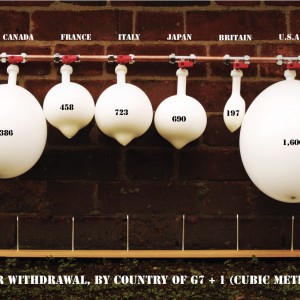Federal Water Tap, April 18: Energy in the Western U.S.
Energy in the West
Several federal agencies are mulling permits for energy projects. The U.S. Forest Service is considering making more than 660,000 acres in western Nevada’s Humboldt-Toiyabe forest available for geothermal leasing. A draft environment impact statement (EIS) is being prepared for release in October.
The Bureau of Land Management has released a final EIS for Southern California Edison’s Desert Sunlight Solar Farm project, a 550-megawatt photovoltaic facility, transmission line, and substation located south of Joshua Tree National Park in southern California. To protest the decision to approve the project, contact Brenda_Hudgens-Williams@blm.gov.
The BLM has also given notice that it will prepare a draft EIS for proposed natural gas drilling in Sublette County, Wyoming. Canadian company EnCana, one of the largest natural gas producers in North America, wants to develop 3,500 wells on some 140,000 acres, using mostly recycled water for hydraulic fracturing. Public comments are being accepted until May 12, and can be sent to NPL_EIS_WY@blm.gov.
Dams on the Mekong
On Tuesday the government of Laos will decide whether to build the Xayaburi Dam on the Mekong River. Senator Jim Webb, who heads the Subcommittee on East Asian and Pacific Affairs, criticized the proposed project in a statement. The Virginia Democrat said the dam “is a dangerously harmful precedent as it relates to the environmental health of Southeast Asia…The United States and the global community have a strategic interest in preserving the health and well-being of the more than 60 million people who depend on the Mekong River.” Sen. Webb recommended delaying the dam and increasing the State Department’s engagement with the region’s river governance body. For more on the dam and its effects, see this New York Times article.
Down the Storm Drain
The Environmental Protection Agency is considering new regulations for managing stormwater from construction sites. The permitting process will now include numerical limits on turbidity, and sediment and erosion controls on other effluents. It will be required in the four states where the EPA has permitting authority (Idaho, Massachusetts, New Hampshire and New Mexico), Washington, D.C., most territories and tribal lands and certain industries (e.g. oil and gas in Texas and Oklahoma). The agency wants to extend current regulations to January 31, 2012 when the new rules would come into effect. The proposed changes are open for public comment.
Federal Water Tap is a weekly digest spotting trends in U.S. government water policy. To get more water news, follow Circle of Blue on Twitter and sign up for our newsletter.
Brett writes about agriculture, energy, infrastructure, and the politics and economics of water in the United States. He also writes the Federal Water Tap, Circle of Blue’s weekly digest of U.S. government water news. He is the winner of two Society of Environmental Journalists reporting awards, one of the top honors in American environmental journalism: first place for explanatory reporting for a series on septic system pollution in the United States(2016) and third place for beat reporting in a small market (2014). He received the Sierra Club’s Distinguished Service Award in 2018. Brett lives in Seattle, where he hikes the mountains and bakes pies. Contact Brett Walton





Leave a Reply
Want to join the discussion?Feel free to contribute!